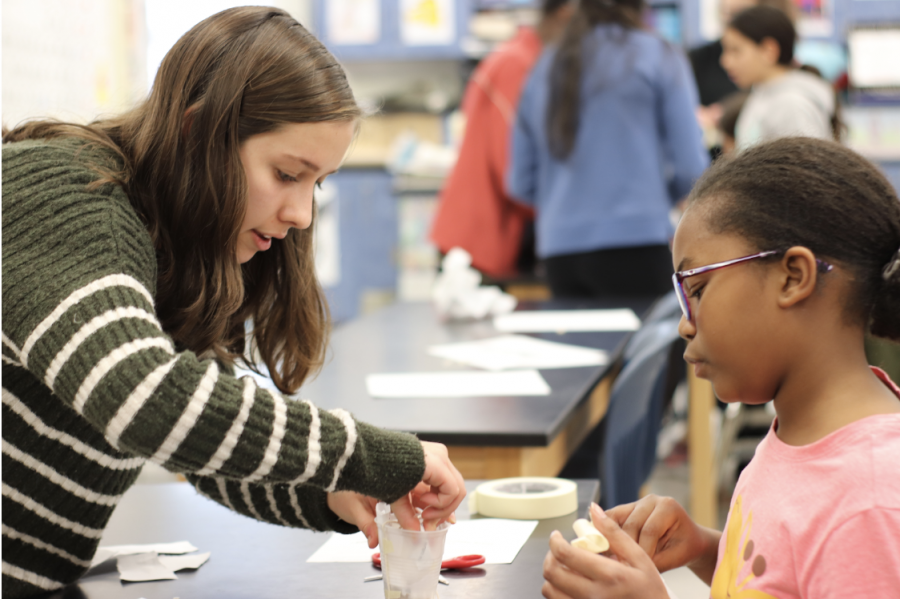Stemming opportunities for the disadvantaged
Jefferson students work to alleviate the disadvantage that lower economic classes face in admissions tests
A 4th grader at Weyanoke Elementary school listens as freshman Megan Enochs explains the science behind constructing a safe and secure container for the egg drop. Enochs is part of a WISE, in which Jefferson students teach girls from Weyanoke Elementary School about scientific concepts through fun experiments.
February 11, 2020
Eraser marks covering the white paper now hidden by grey scribbles. Pencils rushing to complete the test. Pages whooshing as they are flipped through. Each question checked once, twice, thrice. This is the same scene seen in hundreds of schools as thousands of 8th graders complete the admissions test for Jefferson every year. However, rarely are these students on the free/reduced lunch program and even more rarely will the few students who are on the free/reduced lunch program even pass the first round of tests.
Jefferson provides low-cost STEM opportunities to equalize admission chances for all students. However, only 1.98% of the student body was on free/reduced lunch during the 2018-2019 school year. In contrast, schools in similar regions, like Woodson and Chantilly, had almost 6-8 times more students in the free/reduced lunch program: Woodson with 12.83% and Chantilly with 16.47%.
Why is the demography of Jefferson more secluded than that of other high schools in similar regions? Oftentimes, families with a higher income are able to provide their children with greater STEM opportunities, therefore increasing the student’s chances of getting into Jefferson. Sections of the tests require prior STEM experience and involvement. However, some students, no matter how smart, do not have the opportunities to participate in STEM-related activities. Jefferson is trying to establish outreach programs that provide students from demographic minorities at Jefferson with STEM opportunities and college exploration programs for free.
One of these programs is Learning through Inquiry, Fellowship, and Tutoring (LIFT) which was initiated at Jefferson in 2015 by a former teacher, named Scott Campbell. Campbell was instrumental in getting a grant from the Jack Kent Cooke Foundation (JKCF) which funded LIFT for the first two years. Due to the success of LIFT, the Partnership Fund allocated $50000 to sustain LIFT once the JKCF fund ended. This program encourages students to participate in STEM through tutoring for the Jefferson admissions test and providing an insight into STEM opportunities. This service club is free to make it more available to students who may not have the resources to participate in other extracurricular STEM opportunities.
“The people who can’t afford TJ prep or [STEM opportunities] that will help them potentially get into a place like [Jefferson], since we know that [Jefferson] has a lot of opportunities for the kids who are interested in STEM we help them by giving them free tutoring for the TJ test. This will help them if they are trying to get into a STEM career,” junior Yana Patel, the activities coordinator for LIFT, said.
Many teachers at Jefferson also participate in programs such as LIFT. Stephanie Glotfelty, a 9th grade English teacher, taught for LIFT for five years at Jefferson and now sponsors the Jefferson College Partnership Program with Ms. Smith.
“If you happen to be in a family that can’t afford that stuff, or who moved recently to the area…so when you have a lot of military families, they move in and out all the time [and] then have to learn the entire system of how school works here… It just means that the same opportunities are not afforded to certain parts of the population,” Glotfelty said.
LIFT also give students at Jefferson the chance to give back to their community and help other students with interests in STEM. Many students at Jefferson enjoy helping and tutoring younger children through such service clubs. Another program that allows students to tutor and help others is the Jefferson STEMbassadors program, for which students can apply to become a tutor and facilitate STEM activities in elementary and middle schools across the region.
“I really enjoy the opportunity to get to be able to help kids because, personally, I know how it is to not be able to have the ability to do something, but still want it really badly,” Patel said.
Another club that helps with the cause is Women In Science and Engineering (WISE). Focusing on females interested in STEM, club members have 4th graders from Weyanoke Elementary come and do science experiments to enhance skills related to STEM.
“I decided to join WISE because I love working with little kids. And I also love science and it brings back a lot of memories for when I was doing the same things when I was little and I felt like it would be nice to pass that onto [the] future,” freshman Anjali Pillai said.
Although Jefferson has not seen the expected impact of these service clubs on Jefferson admissions, many teachers and club officers feel that they are still making an impact. These clubs many not be diversifying admissions demographics as expected, but they promoting underprivileged students to take an interest in STEM and know that a future in STEM is a possibility for them too.
“So even if the goal of getting kids into [Jefferson] isn’t at fruition, I think the overall goal is getting students to realize that you can do just fine in advanced academics, no matter where it is that you are at,” Glotfelty said.







Elizabeth Mickael • Apr 5, 2020 at 4:13 pm
The TJ test in whole isn’t as holistic as admissions claims to be, especially for the disadvantaged